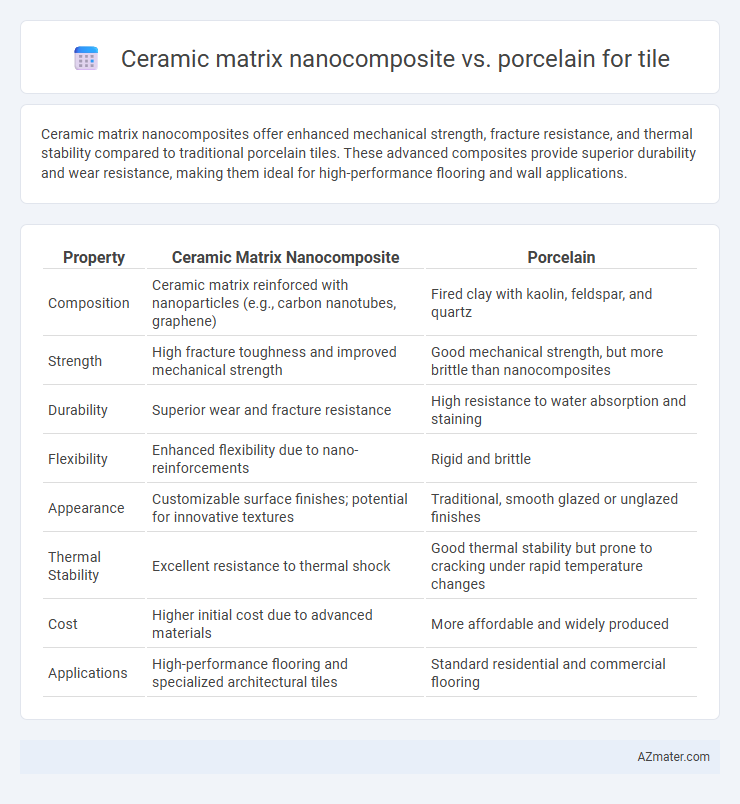Ceramic matrix nanocomposites offer enhanced mechanical strength, fracture resistance, and thermal stability compared to traditional porcelain tiles. These advanced composites provide superior durability and wear resistance, making them ideal for high-performance flooring and wall applications.
Table of Comparison
| Property | Ceramic Matrix Nanocomposite | Porcelain |
|---|---|---|
| Composition | Ceramic matrix reinforced with nanoparticles (e.g., carbon nanotubes, graphene) | Fired clay with kaolin, feldspar, and quartz |
| Strength | High fracture toughness and improved mechanical strength | Good mechanical strength, but more brittle than nanocomposites |
| Durability | Superior wear and fracture resistance | High resistance to water absorption and staining |
| Flexibility | Enhanced flexibility due to nano-reinforcements | Rigid and brittle |
| Appearance | Customizable surface finishes; potential for innovative textures | Traditional, smooth glazed or unglazed finishes |
| Thermal Stability | Excellent resistance to thermal shock | Good thermal stability but prone to cracking under rapid temperature changes |
| Cost | Higher initial cost due to advanced materials | More affordable and widely produced |
| Applications | High-performance flooring and specialized architectural tiles | Standard residential and commercial flooring |
Introduction to Ceramic Matrix Nanocomposites and Porcelain
Ceramic matrix nanocomposites (CMNCs) incorporate nanoscale reinforcements into ceramic matrices, enhancing mechanical strength, thermal stability, and fracture resistance compared to traditional materials. Porcelain, a dense, vitrified ceramic tile made primarily from kaolin, quartz, and feldspar, offers durability and water resistance but lacks the nano-enhanced toughness found in CMNCs. The integration of nanomaterials in CMNCs results in superior wear resistance and flexural strength, making them innovative alternatives to conventional porcelain tiles in advanced applications.
Material Composition and Structure Differences
Ceramic matrix nanocomposites feature a ceramic base embedded with nanoscale reinforcements such as carbon nanotubes or nanoparticles, enhancing toughness and fracture resistance through improved microstructural integrity. Porcelain tiles are composed primarily of fine-grained clay, feldspar, and kaolin, fired at high temperatures to create a dense, vitrified structure that offers low porosity and high hardness. The nanoparticle inclusions in ceramic matrix nanocomposites introduce superior mechanical and thermal properties compared to the homogeneous, glass-like matrix of traditional porcelain tiles.
Manufacturing Processes Compared
Ceramic matrix nanocomposites (CMNCs) involve advanced manufacturing processes such as sol-gel synthesis, hot pressing, and spark plasma sintering to create nano-reinforced microstructures, resulting in enhanced mechanical strength and fracture resistance. In contrast, conventional porcelain tile manufacturing relies on wet pressing and high-temperature extrusion followed by sintering, producing dense and durable but less tough tiles compared to CMNCs. The integration of nanoscale reinforcements in CMNCs enables superior wear resistance and thermal stability, which are challenging to achieve with traditional porcelain tile production methods.
Mechanical Strength and Durability
Ceramic matrix nanocomposites exhibit superior mechanical strength compared to traditional porcelain tiles, due to the incorporation of nanoscale reinforcements that enhance toughness and resistance to crack propagation. These nanocomposites also demonstrate improved durability under mechanical stress and environmental wear, maintaining structural integrity longer than porcelain tiles, which are more prone to chipping and surface damage over time. The enhanced fracture toughness and higher flexural strength of ceramic matrix nanocomposites make them an ideal choice for high-traffic flooring applications requiring long-term performance.
Resistance to Stains, Scratches, and Chemicals
Ceramic matrix nanocomposites exhibit superior resistance to stains, scratches, and chemicals compared to traditional porcelain tiles due to their enhanced nano-reinforced structure that increases hardness and impermeability. Porcelain, while durable and dense, typically shows greater susceptibility to surface wear and chemical etching under harsh conditions. The advanced composition of ceramic matrix nanocomposites results in longer-lasting aesthetic appeal and reduced maintenance requirements in high-traffic or chemically exposed environments.
Design Flexibility and Aesthetics
Ceramic matrix nanocomposites offer superior design flexibility compared to porcelain tiles due to their enhanced material properties, enabling intricate textures and vibrant color integration without compromising durability. These nanocomposites provide a broader palette of finishes and customized shapes, appealing to cutting-edge architectural aesthetics and innovative interior designs. Porcelain tiles, while robust and widely used, have comparatively limited options in intricate detailing and color vibrancy, making ceramic matrix nanocomposites a preferred choice for contemporary design applications demanding both form and function.
Thermal and Moisture Performance
Ceramic matrix nanocomposites exhibit superior thermal shock resistance and lower thermal expansion compared to porcelain tiles, enhancing durability in fluctuating temperatures. Their nanoscale reinforcements improve moisture resistance by reducing porosity, resulting in lower water absorption rates than traditional porcelain. These properties make ceramic matrix nanocomposites more effective for applications requiring thermal stability and moisture protection.
Installation Considerations and Techniques
Ceramic matrix nanocomposites offer enhanced strength and flexibility, allowing for thinner tile profiles and easier cutting during installation compared to traditional porcelain tiles. Porcelain requires precise substrate preparation and a longer curing time due to its dense composition, while ceramic matrix nanocomposites enable faster adhesive bonding and reduced grout joint widths. Both materials demand clean, level surfaces, but nanocomposites tolerate slight substrate imperfections better, reducing the need for extensive surface leveling.
Cost, Availability, and Sustainability
Ceramic matrix nanocomposite tiles typically incur higher costs due to advanced manufacturing processes and specialized raw materials compared to conventional porcelain tiles, which are widely available and cost-effective due to established production techniques. Porcelain tiles boast superior availability globally, benefiting from extensive distribution networks, while ceramic matrix nanocomposite tiles remain niche with limited suppliers. Sustainability favors porcelain tiles as they often incorporate recycled materials and demand less energy-intensive production, whereas ceramic matrix nanocomposites may involve more resource-intensive processes and less recyclable content.
Applications and Future Trends in Tile Materials
Ceramic matrix nanocomposites (CMNs) exhibit superior mechanical strength, thermal stability, and wear resistance compared to traditional porcelain tiles, making them ideal for high-traffic commercial spaces and industrial flooring. Porcelain remains prevalent in residential applications due to its affordability and aesthetic versatility, but the advancement of nanocomposites is driving innovation toward more durable, lightweight, and eco-friendly tiles. Future trends indicate increased integration of nanomaterials to enhance tile performance, smart surface functionalities, and sustainability in construction and architectural design.

Infographic: Ceramic matrix nanocomposite vs Porcelain for Tile
 azmater.com
azmater.com